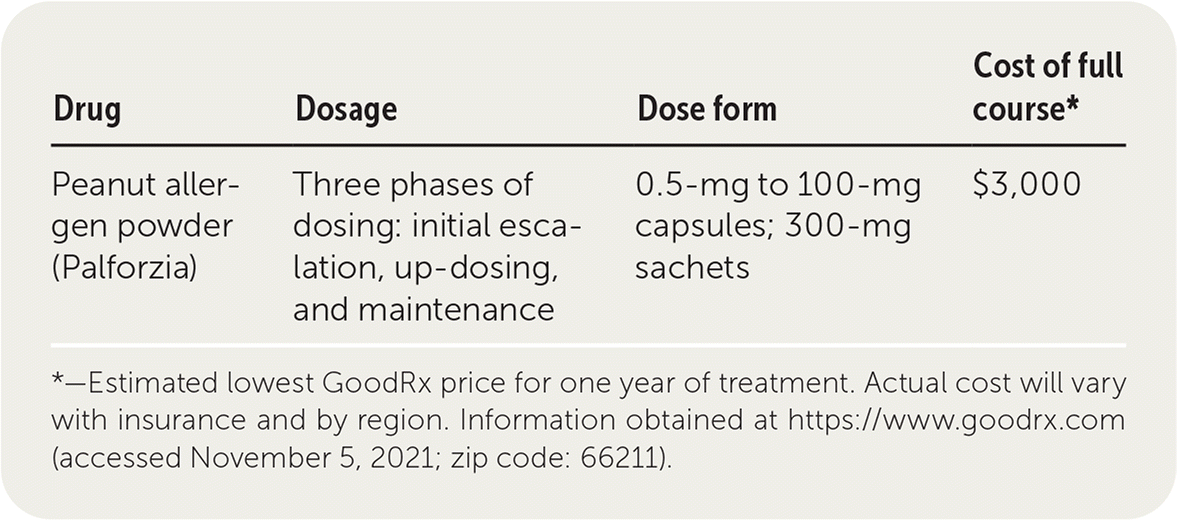
Am Fam Physician. 2022;105(1):20-21
Author disclosure: No relevant financial relationships.
Peanut allergen powder (Palforzia) is an allergen extract for oral immunotherapy. It is labeled for the mitigation of allergic and anaphylactic reactions to accidental exposure to small amounts of peanuts in patients with a confirmed diagnosis of peanut allergy. Use of peanut allergen powder may be initiated in children four to 17 years of age and maintained in adults 18 years and older.1

| Drug | Dosage | Dose form | Cost of full course* |
|---|---|---|---|
| Peanut allergen powder (Palforzia) | Three phases of dosing: initial escalation, up-dosing, and maintenance | 0.5-mg to 100-mg capsules; 300-mg sachets | $3,000 |
Safety
In clinical studies, life-threatening anaphylaxis occurred in 8.7% to 9.4% of patients taking peanut allergen powder vs. 1.7% to 3.8% of patients taking placebo (number needed to harm = 14 to 18).2 The need for epinephrine was 10.4% in the peanut allergen group and 4.8% in the placebo group.1 Peanut allergen powder is contraindicated in patients with severe asthma, eosinophilic gastrointestinal disease, or anaphylaxis for any reason in the previous 60 days. It should not be prescribed concurrently with medications that could interfere with the effectiveness of, or result in harm by, epinephrine administration (e.g., epinephrine can cause hypertensive crisis in patients taking beta blockers). Although peanut allergen powder has not been studied in pregnant patients, anaphylaxis may cause hypotension and corresponding placental hypoperfusion, which can adversely affect a fetus. A registry to collect health information on exposure during pregnancy is available.3 There are no data on the effects of peanut allergen powder on lactation. Use of peanut allergen powder has not been studied in children younger than four years or for the initiation of treatment in adults older than 55 years. Most data include patients four to 17 years of age.2
Tolerability
Abdominal pain affects about one in four patients taking peanut allergen powder (26% vs. 8% in those taking placebo). Other common adverse effects of peanut allergen powder compared with placebo include allergic symptoms such as throat irritation (9.3% vs. 5.1%) and oral pruritus (8.7% vs. 3.1%). About 9.2% of patients taking peanut allergen powder (vs. 1.7% taking placebo) will discontinue therapy because of adverse effects. Unwanted symptoms are short-lived; for doses administered at a medical facility, the median time to resolution of the longest lasting symptom was 37 minutes.2
Effectiveness
In two studies, peanut allergen powder was given to 709 patients; most were male, White, and between four and 11 years of age with a confirmed peanut allergy.1,4 In addition to patients following a peanut-avoidant diet, peanut allergen powder administration in three phases of progressively increased dosing over six to 12 months significantly increased the proportion of patients who tolerated ingesting a small amount (600 mg) of peanut protein, which is equivalent to about a single peanut (difference between peanut allergen powder and placebo groups = 63%; 95% CI, 53% to 73%). There are currently no data confirming generalizability to other populations. The duration of protection after discontinuing peanut allergen powder therapy has not been identified, and real-world effectiveness in preventing anaphylaxis and death is unknown.
Price
Peanut allergen powder costs approximately $3,000 per year for the initial dose escalation and continued maintenance. There are no other similar medications for comparison.
Simplicity
Peanut allergen powder is available in capsules or sachets, both of which should be opened and the powder inside mixed well with food and ingested. Capsules should not be swallowed. Peanut allergen powder is under a restricted prescription program due to safety concerns. To dispense peanut allergen powder, the physician, medical facility, pharmacy, and patient must all enroll in the Risk Evaluation and Mitigation Strategy (REMS) program.2 The first dose is dispensed by a certified pharmacy and administered under physician supervision at a facility equipped to treat anaphylaxis. Treatment occurs in three phases, beginning with five different doses of oral capsules (0.5 mg to 6 mg), each separated by 20 to 30 minutes and given in a single day at a medical facility. The patient is discharged after a final hour of observation. Within one to four days, the up-dosing phase begins for patients who tolerated at least the 3-mg single dose during the first day of treatment, increasing from 3 mg to 300 mg. Patients receive a supervised dose, stay for an hour of observation, and, if the allergen powder is tolerated, continue that dose for two weeks at home before returning for a supervised subsequent higher dose. Patients who cannot follow the regimen of capsule combinations should discontinue treatment. Finally, patients take a maintenance dosage of 300 mg per day. Patients taking peanut allergen powder need a prescription for injectable epinephrine, training on its use, and counseling on keeping it accessible at all times. All patients should adhere to a peanut-free diet.2
Bottom Line
For individuals with severe peanut allergy, peanut allergen powder may lessen the likelihood of life-threatening consequences of accidental ingestion of small amounts of peanuts. Patients must still adhere to a peanut-avoidant diet, which likely has far bigger preventive impact than peanut allergen powder therapy. Peanut allergen powder has significant limitations: patients must carry injectable epinephrine, the allergen powder does not confer the safe ability to ingest more than a single peanut, it cannot be used to treat an allergic or anaphylactic reaction, and it is expensive. Some patients may have allergic or even life-threatening anaphylactic reactions to peanut allergen powder. However, for many, in addition to strictly avoiding peanuts in the diet, completing the peanut allergen powder protocol might possibly reduce the harm of small amounts of inadvertent peanut exposure and provide some peace of mind.
